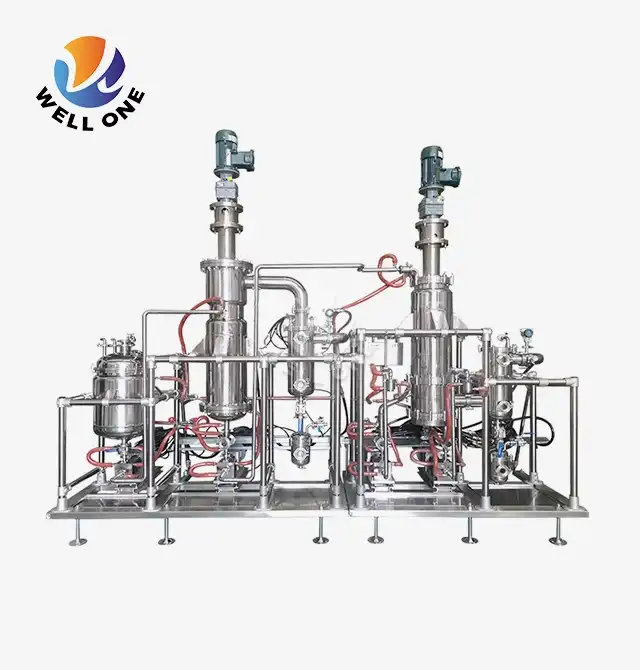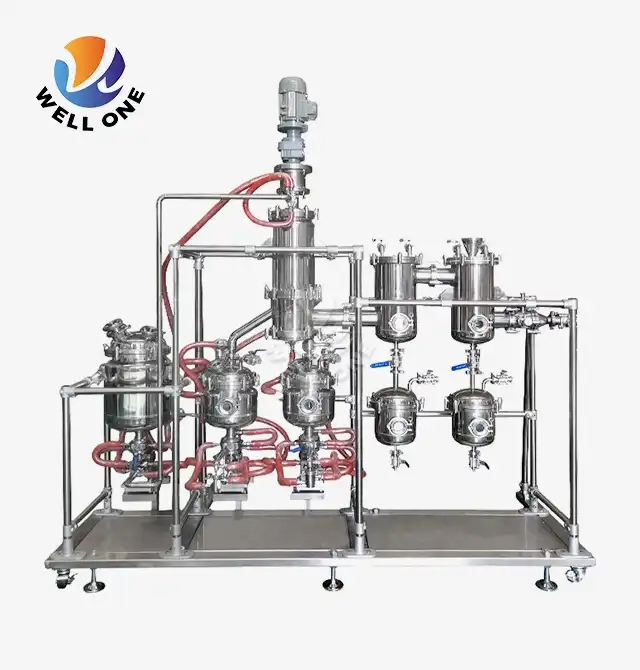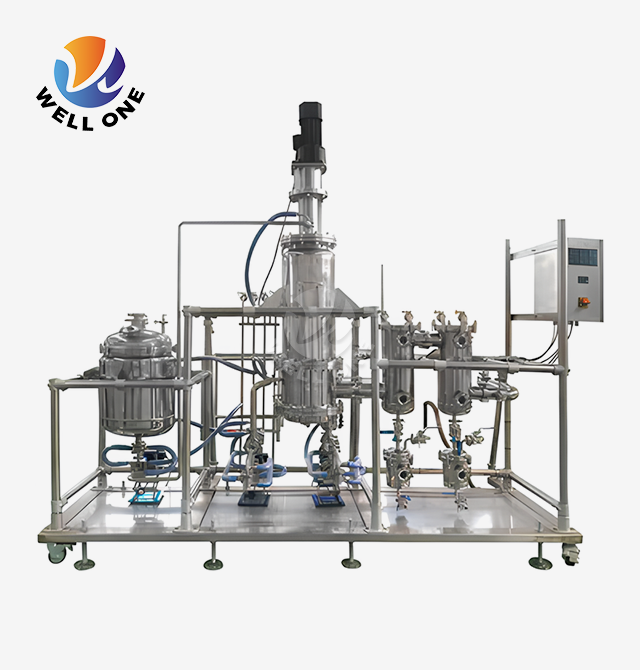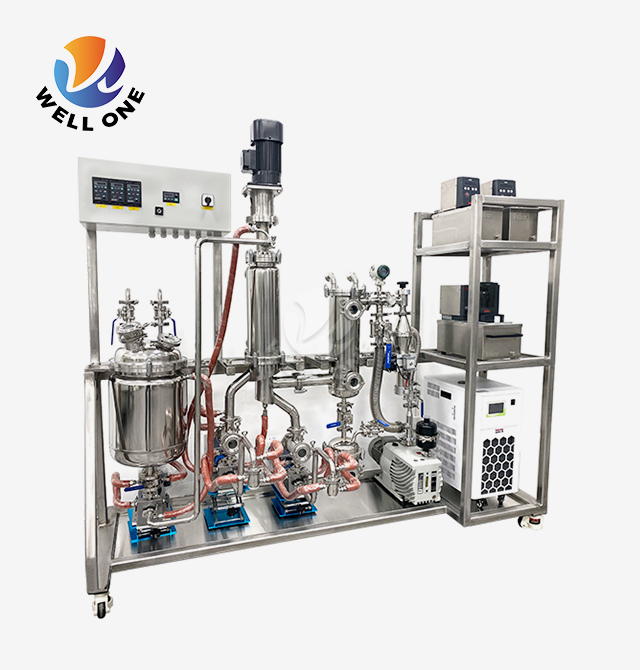Laboratory Equipment Effective Molecular Distillation for Essential Oil Distilling
Essential oil producers face a critical challenge: how to extract and purify delicate aromatic compounds without destroying their therapeutic properties through excessive heat. Traditional distillation methods often degrade heat-sensitive terpenes and volatile compounds, resulting in oils with diminished fragrance profiles and reduced bioactivity. Laboratory Molecular Distillation technology addresses this pain point by enabling separation at extremely low temperatures under high vacuum conditions, preserving the integrity of precious essential oil components while achieving purities exceeding 98%.
Understanding Laboratory Molecular Distillation Technology for Essential Oils
Laboratory Molecular Distillation represents a paradigm shift in essential oil purification methodology. Unlike conventional distillation processes that rely on boiling point differences at atmospheric pressure, this advanced separation technique operates under vacuum conditions as low as 0.1Pa, allowing molecules to travel freely without collisions. The short distance between the heated evaporating surface and the condensing surface—typically just a few centimeters—means that volatile compounds spend minimal time exposed to heat, preventing thermal degradation of fragile aromatic molecules. The technology leverages the principle that different molecules have varying mean free paths at reduced pressures. When the pressure is sufficiently low, lighter molecules with longer mean free paths can reach the condenser while heavier impurities remain behind. This selective separation occurs at temperatures often 50-100°C below traditional boiling points, making Laboratory Molecular Distillation the ideal solution for heat-sensitive essential oils like rose, lavender, and citrus extracts. Modern Laboratory Molecular Distillation systems incorporate 316 stainless steel construction for corrosion resistance and purity maintenance. The material choice is critical when processing essential oils, as reactive metals can catalyze unwanted chemical reactions or leach contaminants into the final product. Advanced ABB control systems maintain precise temperature regulation within ±0.1°C, ensuring reproducible results across batches and enabling compliance with stringent quality standards required by pharmaceutical and cosmetic industries.
Key Advantages of Laboratory Molecular Distillation in Essential Oil Processing
Preservation of Aromatic Integrity
Traditional steam distillation and solvent extraction methods expose essential oils to temperatures exceeding 150°C, causing irreversible damage to delicate terpene structures. Laboratory Molecular Distillation operates between 50-100°C, preserving the original aromatic profile and therapeutic properties. For rose essential oil purification, this gentle processing retains the precious phenylethyl alcohol and citronellol compounds that give rose oil its characteristic scent, preventing the molecular rearrangement and oxidation that plague conventional methods.
Multi-Stage Purification Capability
Single-stage, dual-stage, and three-stage Laboratory Molecular Distillation configurations enable progressively refined purification. In rose essential oil production, crude oil obtained from supercritical CO2 extraction first undergoes water removal in a thin film evaporator, then enters a multi-stage molecular distillation system. The first stage removes residual solvents and light volatiles, the second stage separates the target essential oil compounds, and the third stage polishes the product to pharmaceutical-grade purity exceeding 99%, with residual solvent levels below 10ppm.
Enhanced Recovery Rates and Cost Efficiency
Compared to traditional essential oil purification methods that achieve only 16-30% recovery rates, Laboratory Molecular Distillation systems deliver 70-85% product recovery. This dramatic improvement translates directly to profitability, especially when processing high-value oils like rose, jasmine, or sandalwood. The technology also enables solvent recovery and reuse, reducing operational costs while minimizing environmental impact through closed-loop processing.
Technical Specifications Driving Essential Oil Distillation Excellence
Modern Laboratory Molecular Distillation equipment meets CE, ISO, UL, and SGS certification standards, ensuring compliance with international safety and quality requirements. The high vacuum degree of 0.1Pa creates an environment where molecular mean free paths exceed the distance between evaporating and condensing surfaces, enabling efficient separation without thermal stress. ABB control systems provide automated process monitoring, data logging, and reproducible parameter settings essential for GMP compliance in pharmaceutical and nutraceutical essential oil applications. The 316 stainless steel construction offers superior corrosion resistance when processing essential oils containing organic acids, aldehydes, and other potentially reactive compounds. Surface finish quality directly impacts product purity, as rough surfaces can harbor residues and promote bacterial growth. Premium Laboratory Molecular Distillation systems feature electropolished internal surfaces with Ra values below 0.4μm, meeting sanitary design standards and enabling efficient cleaning-in-place procedures. Temperature control ranges from 50°C to 300°C accommodate diverse essential oil processing requirements. Delicate floral oils like neroli and ylang-ylang process optimally at 60-80°C, while more robust citrus terpenes tolerate 80-100°C. Vacuum levels adjustable from 0.1Pa to 10Pa allow fine-tuning for specific molecular weight distributions, with heavier sesquiterpenes requiring higher vacuum than lighter monoterpenes for effective separation.
Industry Applications Beyond Essential Oil Distillation
While essential oil purification represents a primary application, Laboratory Molecular Distillation technology serves broader pharmaceutical, nutraceutical, and fine chemical sectors. In pharmaceutical manufacturing, the equipment purifies active pharmaceutical ingredients, removes residual solvents from drug intermediates, and concentrates heat-sensitive bioactive compounds. The same gentle separation principles that preserve essential oil aromas also protect vaccine components, peptide therapeutics, and lipid nanoparticle formulations from thermal degradation. Food industry applications include fish oil purification for omega-3 concentrate production, tea oil deacidification, and monoglyceride synthesis. The technology achieves 80% EPA and DHA concentration in fish oil supplements through four-stage distillation, while tea oil processing removes free fatty acids without damaging beneficial antioxidants. Nutraceutical manufacturers rely on Laboratory Molecular Distillation for vitamin E concentration, squalene purification, and CBD isolate refinement, achieving purities exceeding 99% with minimal product loss. Petrochemical and materials science sectors employ the technology for lubricating oil regeneration, epoxy resin purification, and polymer additive recovery. The versatility stems from Laboratory Molecular Distillation's fundamental capability: separating components based on molecular weight and volatility differences without thermal decomposition. Whether processing rose essential oil worth thousands per kilogram or recovering industrial solvents, the core separation mechanism remains equally effective.
Selecting the Right Laboratory Molecular Distillation System Configuration
Essential oil producers must evaluate several factors when specifying Laboratory Molecular Distillation equipment. Processing volume requirements determine evaporator surface area, with laboratory-scale systems offering 0.1-0.5 m² surfaces for research and small-batch production, while pilot and industrial units scale to 2 m² or larger for commercial manufacturing. The number of distillation stages depends on initial oil purity and target specifications—single-stage systems suffice for relatively clean feeds, while three-stage configurations achieve pharmaceutical-grade purity from crude extracts. OEM and ODM customization capabilities enable tailored solutions for unique processing challenges. Custom features include glass feeding tanks for visual monitoring, external condensers for enhanced cooling capacity, integration with upstream stirring tanks for dissolution steps, and modular designs facilitating future capacity expansion. UL-listed electrical components ensure safety compliance in North American markets, while Huber brand auxiliary equipment provides reliable heating and cooling support. Warranty coverage and after-sales support represent critical selection criteria. Reputable manufacturers like Xi'an Well One Chemical Technology Co., Ltd. provide one-year warranties with options for extended maintenance plans. Technical support should encompass process optimization consulting, spare parts availability, and operator training. The best suppliers maintain independent R&D laboratories offering feasibility testing, process development services, and pilot trials before full-scale equipment investment.
Conclusion
Laboratory Molecular Distillation technology revolutionizes essential oil purification by combining gentle thermal processing, high-vacuum separation, and multi-stage refinement capabilities. This advanced approach preserves aromatic integrity while achieving pharmaceutical-grade purity levels impossible with conventional methods, making it indispensable for producers targeting premium cosmetic, therapeutic, and nutraceutical markets where quality commands premium pricing.
Cooperate with Xi'an Well One Chemical Technology Co., Ltd
Since 2006, Xi'an Well One Chemical Technology Co., Ltd has specialized in synthesis and purification separation equipment, backed by extensive R&D and manufacturing infrastructure spanning 6,000 m². Our expert team delivers turnkey Laboratory Molecular Distillation solutions from feasibility studies through industrial-scale implementation, with 19 years of proven expertise across pharmaceutical, food, petrochemical, and fine chemical sectors. We offer premium quality systems constructed from certified materials, comprehensive OEM and ODM customization with 3D design visualization, and integrated services covering research, production, sales, and technical support.
Ready to elevate your essential oil production with High Quality Laboratory Molecular Distillation technology? As a leading China Laboratory Molecular Distillation manufacturer, supplier, and factory, we provide wholesale solutions with competitive Laboratory Molecular Distillation prices and Laboratory Molecular Distillation for sale configurations tailored to your specific purification challenges. Contact our applications specialists at info@welloneupe.com to discuss your project requirements, request technical specifications, or schedule a demonstration. Bookmark this resource for ongoing reference as you optimize your essential oil distillation processes and explore advanced separation technologies that deliver measurable quality and profitability improvements.
References
1. Batistella, C.B., Maciel, M.R.W. "Molecular Distillation: Rigorous Modeling and Simulation for Design and Operation Optimization" - Brazilian Journal of Chemical Engineering
2. Cvengros, J., Lutisan, J. "Molecular Distillation of Heat-Sensitive Materials: Principles and Industrial Applications" - Chemical Engineering Science
3. Wang, S., Zhang, Y. "Application of Short-Path Distillation in Essential Oil Purification and Quality Enhancement" - Journal of Essential Oil Research
4. Martins, P.F., Ito, V.M. "Recent Advances in Molecular Distillation Technology for High-Purity Natural Product Extraction" - Separation and Purification Technology







